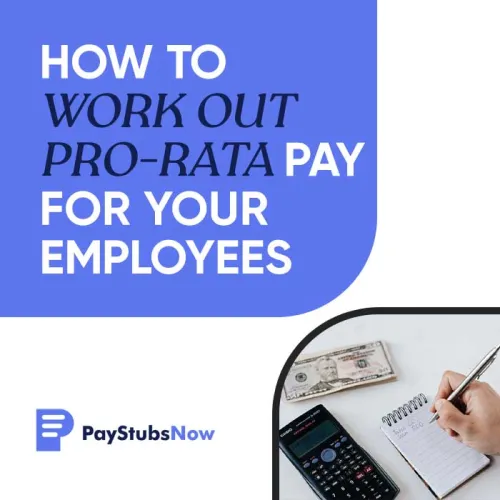


As a business owner or employer, you have probably heard of the term, "pro-rata". However, what you might not have known is that its use case goes beyond the world of business and finance. Here is everything you need to know about pro-rata.
What pro-rata means? How to apply it to your system of compensation? Do you have any ideas on how to work it out and why you should consider a pro-rata payment system or pro rata pay for your employees?

A prorated salary is the payment you make out to an employee's salary in proportion to how much work is done during the entire pay period. This is a Latin term which means "in proportion". While the term can be used in any space, it is mostly used in business and finance today. This means that a worker working pro rata's pay would get a fair share.
As an entrepreneur, you might have to pay pro-rata in the following situations:
While the concept of paying pro-rata is to ensure that you're remunerating an employee for their fair share of work done. There may be extenuating circumstances that can keep a worker out of work and would not require you to pay pro-rata, where an employee is called out of work to perform a civil duty like serving as a witness in a criminal case or fulfilling military obligations.
However, you can save your business by deducting the time lost from your taxes to offset it and balance your account.

Calculating prorated salary is suitable for salaried employees and small business owners. This method allows them to fairly compute the employee's prorated salary based on the number of days or hours worked.
That way, as an entrepreneur, you get to only pay for hours worked and save the company extra expenses from what she is not profiting. Both the employer and employee go home, feeling content with the fairness in the deal.
The primary method to calculate prorated salary involves three major steps:
There's no fixed formula for calculating prorated salary, as it depends on the salary example provided and this figure will depend on whether you pay per hour, per day, per week, or monthly. The bottom line is that an employee's pro-rata pay is derived from dividing the staff's pay in proportion to the number of hours worked.
Benefits are another important factor to consider when hiring someone on a pro-rata basis. Part-time workers are entitled to the same employee benefits and health insurance as full-time employees, according to the Part-Time Workers Regulations.
This means that if you provide a pension to full-time employees, you must also provide one to those who work on a part-time basis. The list does not end with pay-related benefits. If full-time employees get a gym membership or their birthday off as annual leave, part-time employees should as well.

A part-time employee is still entitled to holidays, so let's figure that out as well. There is a quick and easy trick for calculating an employee's pro rata holiday. Multiply the number of working days per week by 5.6. If a pro rata employee works three days per week, their holiday entitlement is three times 5.6, or 16.8 days.
Giving employees 0.8 of a holiday is obviously inconvenient, both for timekeeping and for the employee. It's often practical to round to the nearest whole number to align with payroll information, which in this case is 17. Why is there a 5.6 multiplier?
A full-time employee's basic statutory holiday entitlement is 28 days. This calculation is based on a standard biweekly pay structure where employees are typically paid for five days per week. The sum of five times 5.6 equals the full 28-day entitlement.
If you're planning a salary increase in the middle of a pay period when transitioning to a new pay period, consider all relevant factors. After you've calculated your new fixed salary, review your budget to see if the pay raise fits your financial scope. Job satisfaction is crucial, but ensure your full-time employee compensation isn't compromised when transitioning in the middle of a pay period.
You should also make certain that each new position you take has specific hours and a set start date. Sometimes pro rata positions are posted in a vague manner, and you may find out later that you are not slated to begin working for several months! In these instances, you may need to plan for a few weeks without employment or consider taking out a short-term loan.
There are many options for consumers wishing to apply for a loan, but there are also many illegal and unlicensed lenders out there trying to take advantage of borrowers. If you need a payday loan or a short-term loan, make sure you go to and apply with an FCA-regulated lender or broker.
It's also crucial to remember that whether you work full-time or on a pro-rata basis, you're entitled to the same benefits. According to government legislation, those working part-time should enjoy the same benefits as those working full-time, both financially and otherwise.
So, if your firm provides a private pension or a bonus system to full-time employees, they must provide you with the same opportunities even if you work fewer hours. The same is true for benefits like discounted parking and taking your birthday off as annual leave.

If you're still unclear about working out your employee's pro-rata pay, here is an example. Suppose your employee earns $10,000 annually and works 40 hours per week and you pay $384.62 every two weeks.
Pro rata pay = full-time pay - [hourly pay x pro-rata hours]
Hourly pay = Weekly pay / normal work hours
Weekly pay = Annual pay / 52 weeks in a year
Therefore, this employee's pro-rata pay is $336.52

Having learned how to work out your employee's pro-rata pay, there are other factors worthy of consideration. Factors like tax liability will decrease since the employee's gross pay has also decreased with the pro-rata pay.
You might need to adjust retirement contributions and tax calculations when employees work fewer hours per week. Also, the payroll cycle adjustments may require a reduction in the amount withheld for federal income tax due to fewer hours worked.
Tax calculations might change depending on how many hours per week the employee did not work due to personal reasons. State and local income taxes might also have to be adjusted, depending on the presenting circumstances.

If you're using an online paystub generator for paycheck stubs, you will need to make sure that you fill in the employee's pro rata pay in the appropriate column. The payroll software systematically adjusts for the salaried employee's new pay period, keeping financial records accurate.
You can use paystubs updated system to settle all your paystubs needs. You can also generate other financial documents such as 1099, W-2 forms, and invoices for your business too.